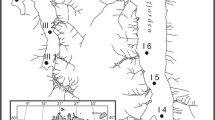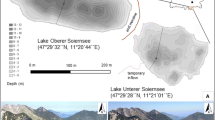Abstract
Three sediment cores from two lakes, Fish Lake and Phalarope Lake, in Truelove Lowland, Devon Island, N.W.T. were analyzed for diatoms and chemical composition. Multivariate statistical techniques using a range of chemical variables successfully isolated three sediment groupings in the cores. Allochthonous and autochthonous chemical components in the sediments have been used to reconstruct paleoenvironmental conditions. The two lakes began approximately 10600 years ago as shallow marine lagoons that were isolated from the sea as a result of glacio-isostatic rebound. Based on the presence of distinctive diatom assemblages, the three stratigraphic zones are identified as a basal marine zone, an intermediate and transitional brackish/marine zone and an upper freshwater zone. Following isolation from the sea, the lakes were flushed with freshwater produced by snow and ice melt. In Fish Lake, the period of transition from marine to freshwater, which began approximately 7000 years ago, lasted approximately 800 years. In Phalarope Lake, which was isolated from the sea approximately 5000 years ago, flushing by fresh water was completed only within the last 300 years. Fe, Cr, and Mo in the sediments are associated with the isolation phase when lake sedimentation is sensitive to the presence of brackish water and erosion within the lake catchments. In particular, the precipitation of Mo as MoS2 reflects the presence of hypolimnetic anoxia associated with lake isolation. During the early post-isolation phase the response of lake biota to an influx of nutrients is reflected in an increase in biological silica and organic carbon in the lake sediments. On the other hand, the generally low organic content of the sediments indicates that sedimentation in these lakes has been largely determined by variations in non-biogenic factors through time. During the mid Holocene the progressive stabilization of surface materials within the lake catchments is marked by decreasing Cr, As and Na in the sediments. At the same time, an increase in allochthonous Mn and Fe is attributed to progressive soil development. During the last 2500 years the catchments have experienced decreased erosion resulting in a decrease in both allochthonous clastic input and lake productivity.
Similar content being viewed by others
References
Allen, A., 1982. SAS User's Guide: Basics, 1982 Edition. SAS Institute Inc., Cary, North Carolina: 921 pp.
Beukens, R. P., 1987. Isotrace Laboratory, University of Toronto, Toronto.
Bliss, L. C., 1977. Introduction. In L. C. Bliss (ed.), Truelove Lowland, Devon Island, Canada: A High Arctic Ecosystem. University of Alberta Press, Edmonton: 1–11.
Canadian Soil Survey Committee, 1978. The Canadian system of soil classification. Canadian Department of Agriculture Publication 1646. Supply and Services Canada, Ottawa: 164 pp.
Cleve-Euler, A., 1951–1955. Die Diatomeen Von Schweden Und Finnland. I-V. Kung. Svenska Vetenskaps Acadamiens Handlingar, Fjarde Serien, Band 2:1, 4:1, 5, 5:4, 3:3. Almqvist & Wiksells Boktrycheri AB, Uppsala. Reprinted in 1968 as Bibliotheca Phycologica, Band 5, Verlag Van J. Cramer, Vaduz.
DeMaster, D. J., 1981. The supply and accumulation of silica in the marine environment. Geochimica et Cosmochimica Acta 45: 1715–1732.
Ekman, P. & M. Fries, 1970. Studies of sediments from Lake Erken, eastern central Sweden. Geologiska Foreningen i Stockholm Forhandlingar 92: 214–224.
Engstrom, D. R. & H. E. Wright Jr., 1984. Chemical stratigraphy of lake sediments as a record of environmental change. In E. Y. Haworth and J. W. G. Lund (eds.) Lake Sediments and Environmental History. University of Minnesota Press, Minneapolis: 11–67.
Engstrom, D. R. & B. S. C. Hansen, 1985. Postglacial vegetational change and soil development in southeastern Labrador as inferred from pollen and chemical stratigraphy. Canadian Journal of Botany 63: 543–561.
Ericsson, B., 1973. The cation content of Swedish postglacial sediments as a criterion of paleosalinity. Geologiska Foreningen i Stockholm Forhandlingar 95: 181–220.
Foged, N., 1972. The diatoms in four postglacial deposits in Greenland. Meddelelser Om Gronland 194: 66 pp.
Foged, N., 1973. Diatoms from southwest Greenland. Meddelelser Om Gronland 194: 84 pp.
Foged, N., 1974. Freshwater Diatoms in Iceland. Verlag Van J. Cramer, Vaduz: 273 pp.
Foged, N., 1981. Diatoms in Alaska. Bibliothica Phycologica Band 53, Verlag. Van J. Cramer, Vaduz: 317 pp.
Germain, H., 1981. Flora des Diatomées. Société Nouvelle Des Editions Boubee., Paris: 444 pp.
King, R. H., 1969. Periglaciation on Devon Island, N. W. T. Unpublished Ph.D. dissertation. Department of Geography, University of Saskatchewan: 470 pp.
Kemperud, A., 1981. Diatom changes in sediments in basins possessing marine/lacustrine transitions in Frosta, Nord-Trondelag, Norway. Boreas 10: 27–38.
Klecka, W. R., 1975. Discriminant analysis. In N. H. Nie, C. H. Hull, J. G. Jenkins, K. Steinbrenner & D. H. Bent (eds.), Statistical Package for the Social Sciences. McGraw-Hill, New York: 434–467.
Lichti-Federovich, S., 1983. A Pleistocene diatom assemblage from Ellesmere Island, Northwest Territories. Geological Survey of Canada Paper 83-9: 59 pp.
Mackereth, F. J. H., 1966. Some chemical observations on post-glacial lake sediments. Philosophical Transactions of the Royal Society, B. 250: 165–213.
Mehra, D. P. & M. L. Jackson, 1960. Iron oxide removal from soils and clays by a dithionite-citrate system buffered with sodium bicarbonate. 7th National Conference on Clays and Clay Minerals: 317–327.
Minns, C. K., 1977. Limnology of some lakes in Truelove Lowland. In L. C. Bliss (ed.), Truelove Lowland, Devon Island, Canada: A High Arctic Ecosystem. University of Alberta Press, Edmonton: 359–585.
Munsell, 1975. Munsell soil color charts. Kollmorgen Corporation, Baltimore, Maryland.
Nelson, D. W. & L. E. Summers, 1982. Total carbon, organic carbon and organic matter. In A. L. Page (ed.), Methods of Soil Analysis. Part 2: Chemical and Microbiological Properties. American Society of Agronomy, Madison: 539–579.
Patrick, R. & L. R. Freese, 1961. Diatoms (Bacillariophyceae) from northern Alaska. Proceedings of the Academy of Natural Sciences, Philadelphia 112: 129–293.
Peragallo, H. & M. Peragallo, 1897–1908. Diatomées Marines de France. Koeltz Scientific Books: 491 pp.
Renberg, I., 1976. Palaeolimnological investigations in Lake Prastsjon. Early Norrland 9: 113–160.
Rettelle, M. J., 1986. Stratigraphy and sedimentology of coastal lacustrine basins, northeastern Ellesmere Island, N.W.T. Géographie Physique et Quaternaire 60: 117–128.
Singer, M. J. & P. Janitzky, 1986. Field and laboratory procedures used in a soil chronosequence study. United States Geological Survey Bulletin 1648: 49 pp.
Stabell, B., 1985. The development and succession of taxa within the diatom genus Fragilaria Lyngbye as a response to basin isolation from the sea. Boreas 14: 273–286.
Tabachnick, B. G. & L. S. Fidell, 1983. Using multivariate statistics. Harper and Row, Publishers, New York: 09 pp.
Wishart, D., 1978. CLUSTAN User Manual. Inter-University Research Council Series. Report No. 47: 175 pp.
Young, R. B., 1987. Paleolimnology of two high arctic isolation basins, Truelove Lowland, Devon Island, N.W.T. Unpublished M.Sc. thesis, Department of Geography, The University of Western Ontario: 148 pp.
Author information
Authors and Affiliations
Rights and permissions
About this article
Cite this article
Young, R.B., King, R.H. Sediment chemistry and diatom stratigraphy of two high arctic isolation lakes, Truelove Lowland, Devon Island, N.W.T., Canada. J Paleolimnol 2, 207–225 (1989). https://doi.org/10.1007/BF00202047
Received:
Accepted:
Issue Date:
DOI: https://doi.org/10.1007/BF00202047




